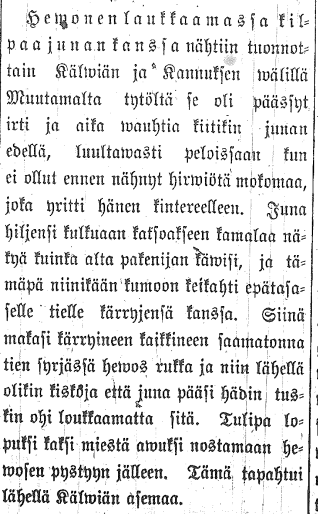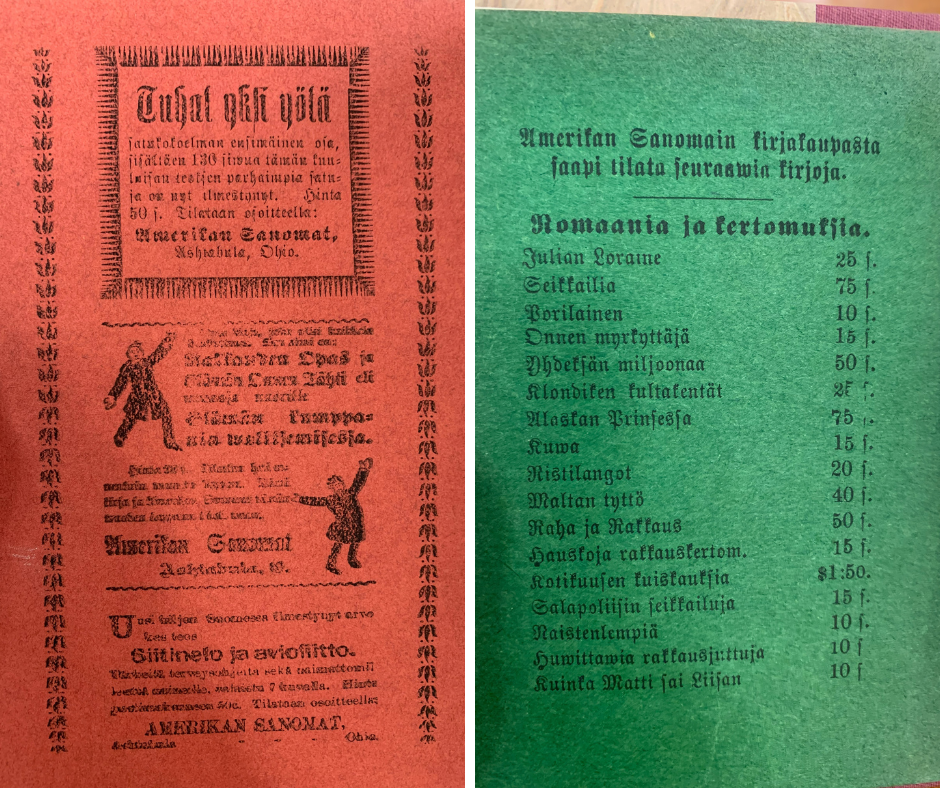AUTHOR: Lotta Leiwo
The News in the Pohjantähti
PART II
The contents of the Pohjantähti consist of news, correspondence letters from Finns around North America and Finland, excerpts from other newspapers, editor’s (Aleksi Wirtamo and Ino Ekman) articles, stories and humor sections, announcements and advertisements. The news sections vary a lot and some of the news are conveyed via correspondence letters from regular people.
Thus, the conventions or the concept of “news” seem to be at test in every issue. In the image you can see a collection of different news sections in Pohjantähti. There is domestic news, foreign news, correspondence letters, local news, telegrams and a mixture of all these.

For us, the most interesting “news” are the correspondence letters that reflect the interests of regular American Finns. The letters inform about local work-related issues such as accidents and vacancies, weather related news and “love news”. Many of the letters are about local people and this makes it possible to draw a picture of key figures in Finnish communities and their networks, plus helps us understand the relationships between people.
As mentioned in an earlier post, the newspaper’s one purpose was to educate the Finnish immigrants. The educational aspect of the newspaper is apparent in several texts in Pohjantähti. Unknown writer on sample issue (Dec 1886) writes:
“We are in a foreign land, far from our old Mother, Finland, but let us try to preserve our language and our nationality in honor of our old Mother and our ancestors! Let us establish schools, build churches, and subscribe newspapers, for church, school and newspapers are the best sources of learning and civilization.” (Pohjantähti N:o 1, 3.1.1887, National Library of Finland).
Additionally, Pohjantähti gives advice both in writing for the newspaper and reading it but also educating its readers in world events, immigrant history and temperance issues trying to guide readers to civilized life in North America. Finnish people at the time were mostly literate, but the conventions of a newspaper and writing to a public audience was not familiar to most of the people. Thus, educating the readers was necessary. The editor in section “What a good newspaper should be like” explains why news sections mix various news types:
“(…) all things must be presented briefly, but at the same time in an amusing way. The news section has a great impact on the reader. One line in the news containing something noble and good about some good endeavor will delight the reader: but another line about cold-blooded murder, mephitic and other atrocities may arouse disgust and horror. But at the same time, the reader’s mind is back to normal when he comes across a new news item, for example a very warm love story. (…) All news are very amusing if they are presented as such.” (Pohjantähti N:o 2, 10.1.1887, National Library of Finland).

In addition to educating the readers in 1887, this text explained to us why peculiar love stories and small anecdotes (such as news about people eating sugar coated flowers in America or horse running away from a train in Kälviä, Finland) are presented in between numerous terrible news about railway disasters, family murders and train robberies.
Another newspaper called the Amerikan Sanomat (American Newspaper) published and edited by August Edwards, already mentioned in this blog, started to appear in Ashtabula in 1897. At the moment (in June 2022), we are going through the Amerikan Sanomat issues to find clues about T-Bone Slim and his relatives. Even though Aleksi Wirtamo didn’t publish a newspaper after Pohjantähti, he pops up in local news section occasionally.
It seems that in the turn of the century, the American Finnish newspaper format had settled and different news sections had found their place in the paper. And probably the vernacular audience had learned the newspaper conventions as well. Yet, there is still relatively extensive correspondence section where Finns across American Finnish communities and increasingly from Canada and Finland, too, sent their letters and local “news” for everyone to read. Additionally, all kinds of amusing texts (stories, anecdotes and funny news), comical pictures and jokes takes its place in the paper among the edifying and educational content. The Amerikan Sanomat also held a writing competition (at least) in 1901. The Amerikan Sanomat publishing company published the competition texts and other small stories and poems in small booklets. Next in our blog, we’ll discuss about few examples from this interesting material!



